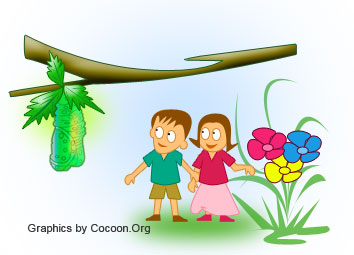Cocoons in the Winter
The late autumn is a really wonderful time for children to go out to look for Cocoons. It is at this time that there are shorter daylight hours and cooler temperatures, both of which signal caterpillars that winter is coming and it is time to go into a Cocoon. As such, caterpillars who have grown fat over the summer spin Cocoons around themselves so that they can develop into moths over the wintertime. These Cocoons will keep the caterpillars safely disguised so that birds and other predators will be unable to find and eat them. This is why so many Cocoons are made to look like leaves and nuts. For instance, the Luna moth creates a Cocoon around itself that is brown and the size of a large pecan.
If children are able to find these Cocoons they can place them inside of a glass canning jar that has some small air holes in the lid. There is no food or water needed here because while inside of their Cocoons these insects do not eat or drink. These should then be kept in a cold place like your garage, shed, attic or inside of your refrigerator. This is very important, because your moth will not hatch unless it stays cold for several months.
 When early spring arrives you can take your jar out and let it start to slowly warm up. Once the days are warmer you should watch your jar for signs of life as your moth will hatch. You will want to read about this ahead of time. This will help you to understand why you will need to be patient while you wait for your moth to hatch.
When early spring arrives you can take your jar out and let it start to slowly warm up. Once the days are warmer you should watch your jar for signs of life as your moth will hatch. You will want to read about this ahead of time. This will help you to understand why you will need to be patient while you wait for your moth to hatch.
After you have spent this time learning about moths and watching your very own moth, you may find that you have a newfound respect for them.
Bee Cocoons
What is a Cocoon
Cocoons in the winter time
How long Cocoon Last?
Silk Made From Cocoon
Silkworm Cocoon
Orgin of word Cocoon
The Surprises in Cocoons
Types of Insects in Cocoon
Butterfly or Moth Cocoon
Making of Cocoons
Ant – Cocoon Connection
From Cocoon to Adult: Role of Hormones
Cocoon that resembles a Bag
Cocoon Architecture
Mud Cocoons
Interesting Cocoons
Cocoon Food
Glochidium Cocoon
Sleeping Bag Cocoon
Cremaster, Nature’s Velcro
Frog Cocoon
Earthworm Cocoonv
Cocoon Rattles
Mites And Bee cocoon
Say No to Silk
Cocoon Inside Cocoon
Sensing From Inside Cocoon
Cocoon That Resembles Rabbit droppings
Hammock Shaped Cocoon
Chipwood Cocoon
Slime Cocoon
Cocoon For Eggs
